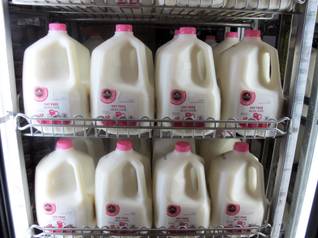
Associated Press
A complicated mix of factors has combined to send milk prices up 25 percent over the last decade
Sunday, Nov. 3, 2013 | 2 a.m.
During the ongoing debate about whether to raise the county sales tax rate to hire more police officers, the effect on valley residents' pocketbooks has been a central concern for Clark County commissioners.
The proposed maximum increase of .15 cents would be on top of the current sales tax rate of 8.1 percent. But with an increase in the fuel tax rate that will add 10 cents to the price of a gallon of gasoline and a hike in rates from the Southern Nevada Water Authority both approved in recent months, costs for the average resident keep rising.
These additional costs come on top of rising prices for everything ranging from a gallon of milk to tuition at UNLV.
Here’s a look at how six common costs have increased for residents in recent year:
-
Electricity - $146.63 per month
The amount the typical valley family paid to NV Energy each month increased steadily each year in the early 2000s, but has flattened in recent years and even dropped in 2011 due to the recession.
Still, monthly prices have increased by nearly 50 percent, up from an average of $99.73 in 2003 to a current total of $146.63. That figure is based on an average use of 1,245 kilowatt hours per month in a single-family residential unit. Electricity usage can vary month to month, depending on the season.
Electric bills are driven by a variety of factors, including the cost of fuel, renewable energy mandates, energy efficiency charges and NV Energy’s construction spending.
-
Milk - $3.45 per gallon
The cost of staple food items, from milk to eggs to bread, has been increasing faster than inflation over the last decade, a trend marked by volatile swings in the price of goods. A complicated mix of factors has combined to send milk prices up 25 percent over the last decade, from an average of $2.76 per gallon in 2003 to $3.45 currently, according to the most recent figures from the U.S. Bureau of Labor Statistics.
Rising costs of energy, shocks to global commodity markets, major weather events and the recession have all factored into increasing food prices.
-
Gasoline - $3.61 per gallon
The days of a $2 gallon of gasoline may seem like ancient history, but it was only nine years ago when the average cost of a gallon of gas was $1.88.
Since then, the price of a regular, unleaded gallon of gasoline has skyrocketed nationally, nearly doubling to $3.61, according to the most recent data from the Bureau of Labor Statistics.
The price of gasoline was characterized by sharp spikes over the course of the decade, peaking in 2008 before dropping by 90 cents per gallon in 2009 as the economic recession swept over the country. Costs have been on the rise since, although they have declined by about 4 cents per gallon in 2013 compared to last year.
-
Water - $34.34 per month
The average Las Vegas Valley Water District residential customer uses about 10,000 gallons of water per month. A decade ago, that cost an average of $18.21 per month, although that figure can vary wildly depending on the season. That figure has steadily grown and nearly doubled since, reaching $34.34 per month in 2013.
The rising costs are attributable to many factors, most importantly higher rates. Rate increases were necessitated by a steep decline in the Water District’s revenue from connection fees paid by developers that dried up during the recession and upcoming debt payments on billions of dollars’ worth of infrastructure installed during the valley’s boom.
Water rates will continue to increase each of the next three years for residents across the valley after the Southern Nevada Water Authority approved a rate hike in September.
-
Rent - $664 per month for one-bedroom apartment
The housing market crash sent rental prices tumbling, making them one of the few areas over the past decade where prices haven’t increased. Average rent for a one-bedroom apartment has dropped about 13 percent since peaking at $767 in 2007, according to data from UNLV’s Center for Business and Economic Research.
The drop has been mirrored by an increase in unit vacancies, with about 10 percent sitting empty in the third quarter of this year, nearly double the rate from 2007.
Elevated vacancy rates have helped keep rents down, even as the housing market recovers, although there has been slight growth in rental prices in recent months.
-
UNLV tuition and fees - $6,570 per year
The cost of attending college has been on the rise throughout the country, and UNLV hasn’t been exempt from the trend.
Undergraduate tuition at the school have increased by 81 percent since 2007, in large part to offset hundreds of millions of dollars in cuts in state higher-education funding.
Cost per credit is $191.50 per credit hour for an in-state student. With fees added, in-state students taking a full course load of 15 credits per semester can expect to pay about $6,600 per year, compared to $3,600 in 2007.
An out-of-state resident taking a full class load can expect to pay about $20,000 annually in tuition and fees.
These figures don’t cover books, supplies or housing.
javascript:void(0);

Join the Discussion:
Check this out for a full explanation of our conversion to the LiveFyre commenting system and instructions on how to sign up for an account.
Full comments policy